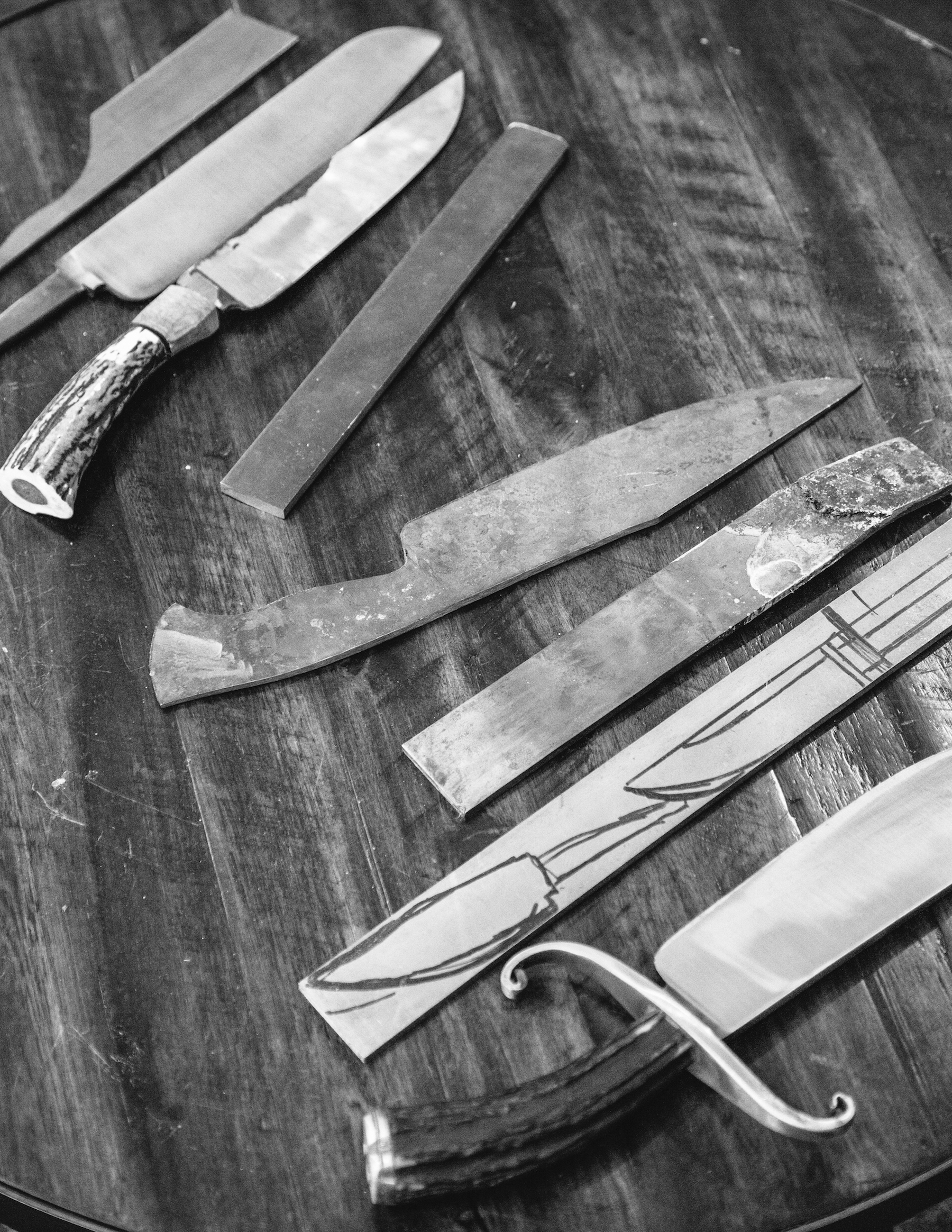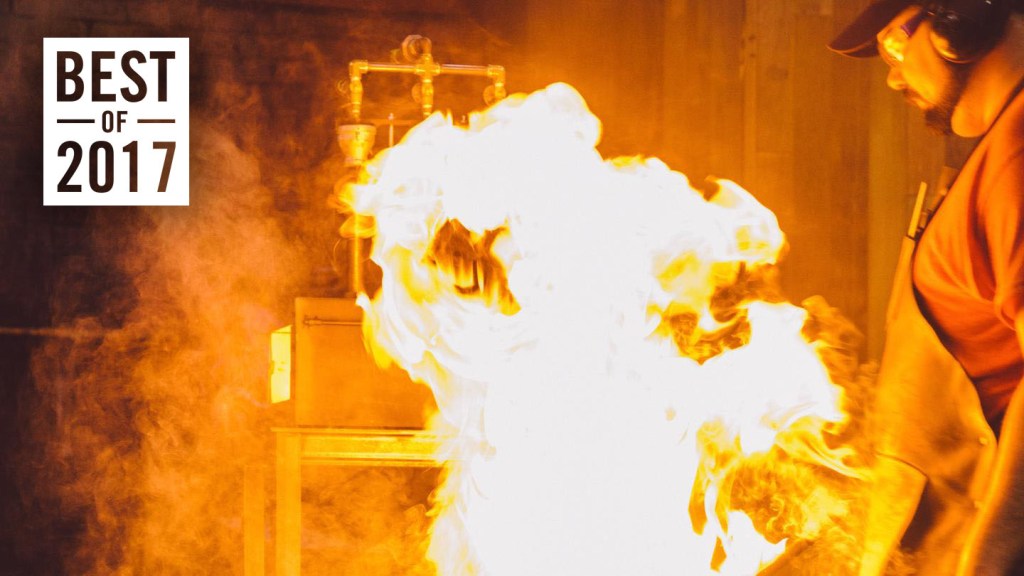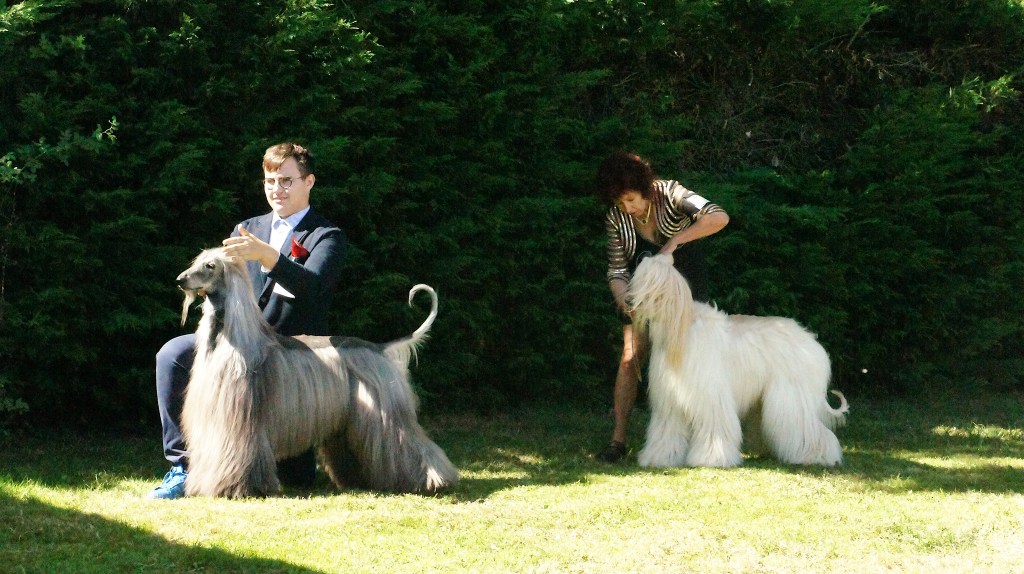The Forged in Fire set is very loud. Fulfilling the promise of its name, the Brooklyn studio where they film HISTORY’s bladesmithing competition reality show contains both forges and fire— lots of fire. Sparks fly off grinders, flames balloon out of quench oil, flames casually spill out the sides of forges, and little fires constantly break out and recede every time a bladesmith drops metal on the floor.
Four contestants—all white men, from various parts of rural America—work in a panicked sweat to complete this episode’s first challenge: making a functional blade out of a rusted old car, with only three hours to spare. Forging a good knife usually takes days, so this is no small feat. The judges coolly observe the action away from the cameras, occasionally returning to their designated seats at the judging table to film their commentary. For a show centered on making deadly weapons, everyone on Forged in Fire is awfully nice. “Eve, he’s about to quench, you don’t want to miss this!” says Wil Willis, the host of the show who can only be described as a hunk.
Videos by VICE
Willis is the only member of the cast who isn’t a blade expert of sorts. He spent 14 and a half years in the armed forces before hosting television shows; even though he didn’t know much about bladesmithing before he began working on the show—which is now in its fourth season—he’s learning how to smith himself. During a break from shooting, Willis proudly shows me a knife he forged as a gift for his son’s high school graduation as he asks judges J. Neilson (a Master Smith at the American Bladesmith Society) and David Baker (a historical weapons recreation expert) for advice on how to address some problematic blade areas.
Forged in Fire isn’t about the contestants, or even the judges: it’s about knives, swords, and how to make them. Similar to Food Network’s perpetual hit sensation Chopped, it’s allergic to the human drama that made the reality shows of the early aughts so enthralling. Forged in Fire is about one thing, and one thing only: the art of the blade.

Forged in Fire is the second most popular nonfiction show on HISTORY, with 1.1 million adults ages 25-54 and 988,000 between the ages of 18-49 tuning into its fourth season. But I came to the set of Forged in Fire for one simple reason: I fucking love knives.
I don’t look like someone with a sustained interest in blades—I’m a young woman, born and bred in New York City, with spindly long arms that seem too weak to wield a sword. (I own a katana, though, so I’m working on it.) Until February of this year, when I stumbled upon Forged in Fire while channel-surfing at a hotel, I didn’t think much about knives. But as soon as I began watching the show, I fell in love. There’s something uniquely relaxing and intellectually exciting about watching bladesmiths work, as they transform a piece of metal into a functional tool, an ancient craft that is the bedrock of society.
I have a pipe dream of abandoning my writing career and retiring in the middle of nowhere so I can make knives. Right now, I spend my days slumped over a computer, staring a screen that delivers me with an endless stream of political horrors I’m somehow supposed to make sense of, and running away from society to make things with my hands would be good for me. My sword-making aspirations exist only in my fantasy world, especially now that I’ve watched every episode of Forged in Fire and understand how difficult and strenuous the process is.

Each episode’s separated into three challenges, each ending in a contestant elimination. First, contestants have to create a fully functional blade within specific parameters in an impossibly short amount of time. Then, they have to attach a handle to their blade, tested for strength, durability, and sharpness. Finally, the two remaining contestants return home to forge an iconic sword from history in five days, the winner taking home a $10,000 check.
Forged in Fire doesn’t have ruthlessly nasty judges like American Idol‘s Simon Cowell or Gordon Ramsay—but they nevertheless have their quirks. There’s Doug Marcaida, whose kindly demeanor isn’t what you’d expect of an ex-military edged-weapons specialist. He performs the kill test—or as fellow judge Dave Baker calls it, “Dougie’s dance of death”—using the contestants’ weapons to skillfully murder a ballistics dummy. He stabs the dummy’s internal organs until they explode with fake blood, finishing with a big smile and his signature catchphrase, “Your blade…will kill.”
Although Marcaida is an expert in designing combat knives, he rejects the inherent violence of his profession. “One of my mottos is it’s not about how many you hurt it’s about how many you protect,” he explains; he stumbled into his catchphrase accidentally, the viewers ostensibly charmed by the happy-go-lucky way he informs the contestants of their blades’ power. “It’s a family show—there are a lot of kids watching it—so I changed the ‘kill’ into ‘KEAL’: KE, Keep Everyone, AL, Alive,” he says. “The show isn’t about glorifying violence…These are weapons, but we’re having fun. It’s a competition. It’s educational.”

Baker resembles a dapper Colonel Sanders and is the natural performer of the judges’ table; taking me to a special closet full of swords from past episodes, Baker giddily chats about what he knows best—sword history. Explaining the symbolism contained within his deadly weapons, he said to me, “I don’t want to be rude, but it’s like a man’s…” He trails off, leaving me to finish the thought. Baker got his start in film and television by recreating weapons from history for film and television, and he’s the sword man of the judging panel. Before they shoot each episode, Baker performs the final challenge himself to ensure it’s doable; Neilson, the knife guy, does the same for the first two challenges.
If Forged in Fire did have a stereotypically mean judge, it would be Neilson. “They didn’t hire me for my comic timing,” he dryly noted. “If people think I’m mean, it’s because I’m the technical guy.” On camera, Neilson is stoic and not particularly keen on smiling or showboating; A nationally acclaimed bladesmith with a popular series of how-to DVDs, Neilson found his passion through movies like Conan the Barbarian and began making blades in teens. (A recent Forged in Fire contestant came on the show with eight months of bladesmithing experience; he’d taught himself using J. Neilson’s DVDs. He won.)
Off-camera, Neilson proudly shows me videos of his children—ages 9 and 14—forging their first knives in his shop and testing them by slicing a water bottle in half. His children only became interested in what their dad does after Forged in Fire began to air, he tells me; indeed, my conversations with the judges included dozens of anecdotes about people telling them that Forged in Fire piqued their interest in bladesmithing.
As a flustered young smith named Josh works away at converting the used car metal, Neilson stares him down with his arms crossed. As Josh explains to the film crew that he’s preparing to quench his blade, Neilson says, “He’s too busy giving bladesmithing lessons to get his quench right.”
A quench happens after a smith forges their steel into the shape of a blade; the blade has to be quenched in either oil or water to harden the steel. If you mess up, your knife is more or less guaranteed to break during the rigorous tests the judges subject the weapons to. (Shooting the blade with copper bullets and pounding the weapon on bamboo and cow bones are a few of the show’s strength tests.) Quenching in water is basically a kiss of death because it cools down the blade too quickly, making it vulnerable to cracking.
Josh’s cinematic quench has Neilson pissed off. He’s heated his quenching oil too much, an intentional gesture by Neilson’s measure; the hotter the oil is, he explains, the bigger the flame is during the quench. With an eyeroll, he says to me, “The camera guys who have been on this show for three seasons know more about bladesmithing than this guy.”

If the judges of Forged in Fire taught me anything, it’s that anyone can make a knife—which is important to emphasize when you consider that the majority of the show’s contestants happen to be white men from rural America. (There have been a sizable number of women and people of color who have competed on the show, and won.)
“This has been a male-dominated industry because they see the fire—the muscle. Even I thought that’s what every blacksmith was supposed to be,” Marcaida explains. “But when you understand the science and are educated on how to do it, you realize anybody and everybody can do it.”
Baker offers up his own anecdote about the gender inclusivity fostered by Forged in Fire: “A guy stopped me on the street and told me, ‘My daughter, she asked for an anvil for her birthday. She’s six’….The women we’ve had on this show are incredibly talented. They’re coming out here and knocking it out like any of the guys do.” “I get far more messages from people who watch this show with their daughters than their sons,” Marcaida adds.
“It really is a craft anyone can do,” says Neilson. “I was just talking to a guy the other day who was wheelchair bound. Watching this show got him interested in banging out blades, and now he’s actually making knives and feeling productive again.”
For professional bladesmiths, competing on the show is a huge honor in itself. As David, one of the contestants competing during my set visit, explains to me, “If I win, $10,000 isn’t going to change my life. But my purpose for coming onto this show is to be part of this renaissance of bladesmithing. We work in obscurity. Nobody knows what we do. Nobody knew how hard it is to do what we do. And this show gives awareness—I mean, you’re a kid, a young woman, and this show grabs you. You know what damascus is, you know what quenching is—because you’ve watched the show.”

After the first challenge wraps up, the judges went to examine the knives before shooting the elimination round. There was a sense of disappointment in the air as they approached the blade made by Randall, a sweet and scrawny older man who’s been a part-time bladesmith for 30 years. Despite his experience, he struggled with the challenge more than the other contestants, and unfortunately for him, it appeared he’s not going make it onto the next round. There was a wave of sad, heavy sighs from the judges and Willis.
“It was a little tougher than I thought it would be,” Randall told me after they finished filming. “My knife,” he let out a deflated laugh, “is terrible.” David, who fared much better in the challenge than his competitor did, kindly assures him, “No matter how this goes for either of us, I bet you’ll get inquiries and orders. That’s what I’ve been told.”
The judges are all sincerely rooting for the contestants to succeed because, above all, they love good knives. In the infrequent occasion when a contestant’s knife breaks in the testing process, Baker and Neilson get emotional; Baker jokes that he needs “to take the afternoon off” when it happens.
Their passion for bladesmithing is inherently ideological. “I have the conversation a lot with people, where they’re like okay, say hypothetically this knife is like $700, why would I spend that much on a knife when I could go down to Walmart and get a knife for $49?” Neilson says. “Because it’s a mass-produced, punched out, everything has become a disposable society, and it’s got no soul.”
That’s what makes Forged in Fire so compelling: it’s all about putting hard work into creating a tool by hand from start-to-finish, which seems refreshing in our modern world. Unlike the majority of junk I impulse-order off Amazon, or the cheaply made clothes I wear, a handmade knife can last for centuries. The hours of labor and skill that goes into bladesmithing demands a different relationship with objects, presents an appealing worldview where not everything you own is trash. After telling me an anecdote about the cheapness of mass-produced bayonets in the military, Willis sums up this feeling the way only a true bladesmith can: “People are tired of garbage.”

Follow Eve Peyser on Twitter.




